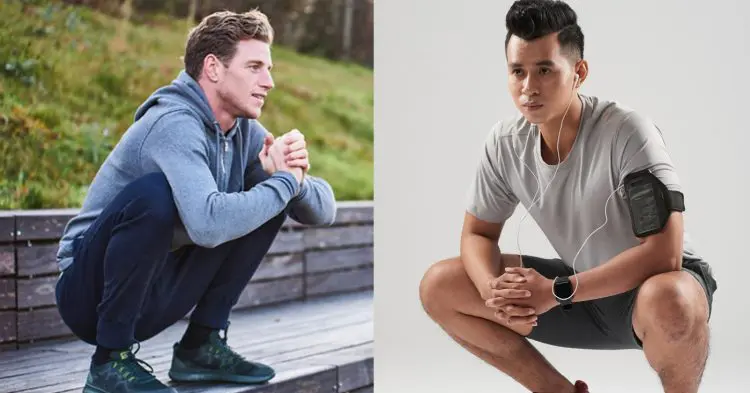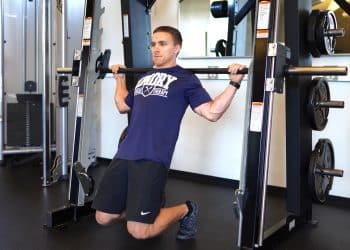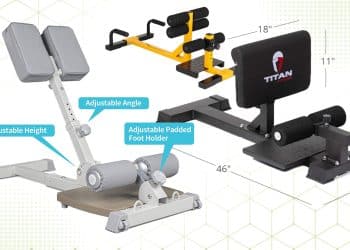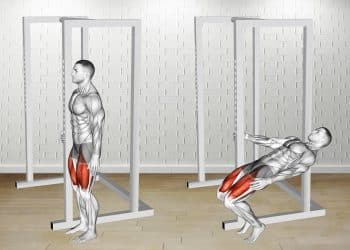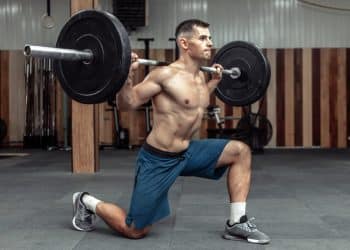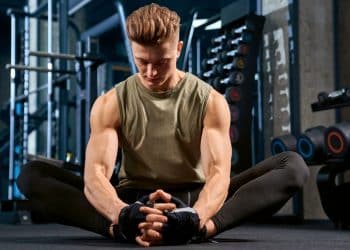When you were a child, you had amazing mobility and flexibility. Your joints were free to move naturally, and you could bend and twist in ways that most adults can only dream of.
But, as you get older and spend more time sitting and less time moving, your joints start to stiffen up. Because of lack of use, muscles become shorter and tighter, and your flexibility will take a nosedive.
With each passing decade, your mobility and flexibility will continue to decrease. As you approach old age, there is a very good chance that you’ll become “as stiff as a board,” which will make many daily activities far more challenging than they should be.
While this series of events is natural and to be expected, it doesn’t have to be the case. You CAN prevent your muscles and joints from losing flexibility and mobility. You can also improve your mobility and joint health even if you’ve started to tighten up.
Hat’s why every good workout plan should include stretching and mobility exercises. If you don’t use it, you WILL lose it!
The ATG (ass to grass) Split Squat is a popular exercise that can help improve or restore your lower body mobility and flexibility while increasing your functional strength.
Level Up Your Fitness: Join our 💪 strong community in Fitness Volt Newsletter. Get daily inspiration, expert-backed workouts, nutrition tips, the latest in strength sports, and the support you need to reach your goals. Subscribe for free!
In this article, we reveal why and how to do this exercise, plus the seven best variations and alternatives to try.
ATG Split Squats – Muscles Worked
The ATG split squat is a compound exercise, which means it involves multiple muscles and joints working together. In fact, it’s safe to say the ATG split squat works all the muscles of the lower body.
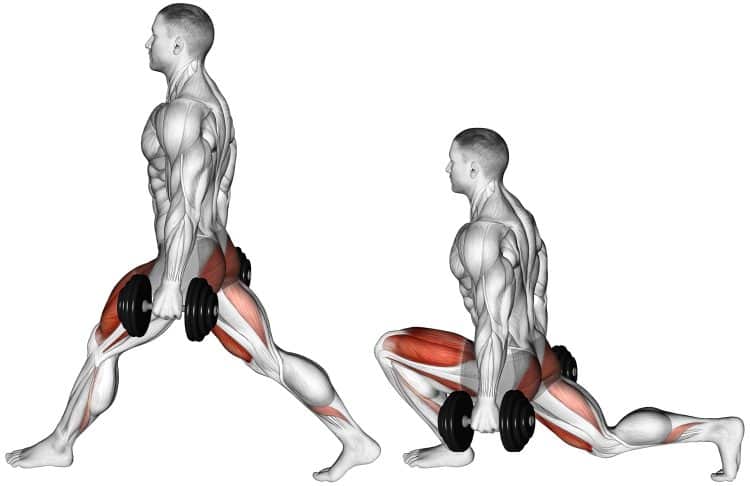
That said, the main muscles you’ll feel working during ATG split squats are:
- Quadriceps – there are four quad muscles: the rectus femoris, vastus lateralis, vastus medialis, and vastus intermedius. The quads extend your knee and flex your hip. Both actions occur during ATG split squats.
- Gluteus maximus – the glutes are your main hip extenders. ATG split squats involve a large range of hip motion, so the glutes are very active during this exercise. The glutes are basically your butt.
- Hamstrings – located on the back of your thighs, the hamstrings flex your knees and work with your glutes to extend your hips. The three hamstring muscles are the biceps femoris, semimembranosus, and semitendinosus.
- Hip abductors – the hip abductors are a group of muscles that lift your legs out and away from the midline of your body. The abductors are gluteus minimus, gluteus medius, and the tensor fascia latae, which are located on the outside of your hip and thigh, respectively. During ATG split squats, these muscles mostly work as hip joint stabilizers.
- Hip adductors – located on the inside of your thighs, the hip adductors pull your legs in toward the midline of your body. The adductor muscles are longus, brevis, and magnus, meaning longest, shortest, and largest.
- Hip flexors – this group of muscles does as its name suggests; they flex your hip! ATG split squats provide the hip flexors with a deep, dynamic stretch, especially in the trailing leg. The main hip flexors are the iliacus and psoas major, which are collectively called the iliopsoas.
- Triceps surae – better known as your calves, the triceps surae comprises your gastrocnemius and soleus muscles. ATG provides this muscle group with a deep stretch, and they are also involved as an ankle stabilizer muscle.
- Tibialis anterior – located on the front of your shin, the tibialis is a long, thin muscle that pulls your toes upward in a movement called dorsiflexion. This muscle is often very weak because it’s seldom trained directly. Pulling your knee forward over your toes means this underused muscle will receive a welcome workout.
So, as you can see, the ATG split squat is a very comprehensive lower-body exercise. In fact, it’s hard to think of any leg muscles that aren’t involved in this stretching and strengthening exercise!
How to Do ATG Split Squats
Get more from ATG split squats while keeping your risk of injury to a minimum by following these guidelines:
- Take a large step forward, so your feet point forward and are about hip-width apart. Brace your core and pull your shoulders down and back. Look straight ahead.
- Bend your front leg and slowly and smoothly sink forward and down while keeping your rear leg as straight as possible. Your torso should remain relatively upright.
- Push your front knee forward so that it travels beyond your toes. Do your best to keep your front heel flat on the floor. However, this may be impossible if you have overly tight calves and ankles.
- Your rear leg should remain engaged. Contract your quads and glutes to keep your leg extended. Hold this position for 2-3 seconds.
- Push backward with your front leg until your knee is straight.
- Slowly descend into another rep.
- Do 6-8 slow, controlled reps, and then rest for a moment.
- Switch legs and repeat, doing the same number of reps on both sides.
Tips:
- Increase your range of motion rep by rep as your muscles lengthen, and your mobility improves.
- Do this exercise next to a wall if balance is an issue.
- Hold dumbbells to make ATG split squats more challenging.
- Place the heel of your front foot on a weight plate or wedge to increase the range of motion in your ankle.
Related: ATG Squat – Muscles Worked, How-To, Benefits, and Alternatives
ATG Split Squat Benefits
Not sure if ATG split squats deserve a place in your next leg workout? Consider these benefits and then decide!
Increased ankle mobility
Many people avoid letting their knees travel beyond their toes. This is no reason to do this, and the main reason that taking the knees past the toes is so often frowned upon is that most people cannot do it!
ATG split squats use your bodyweight to deliver a deep and effective calf stretch which will make getting your knees forward of your toes much easier. This will help you squat deeper, run faster, and jump higher.
Increased hip mobility
Prolonged sitting means that most people have very tight hips. This can affect posture and hip function and is a leading cause of lower back pain. ATG split squats deliver an intense hip stretch which, in time, will produce significant increases in hip mobility.
Strong, mobile, stable knees
Like bilateral ATG squats, ATG split squats are actually very good for your knees. This exercise takes your muscles and joints through a large range of motion that can help alleviate stiffness while improving joint stability and health. Providing you don’t have severe chronic knee pain, ATG split squats could help prevent knee problems in later life.
Increased tibialis anterior strength
Pulling your knee in front of your toes, which is a movement called ankle dorsiflexion, is the job of your tibialis anterior muscle. Located on the front of your shin, this muscle is often weak and underdeveloped.
ATG split squats are one of the few bodyweight-only exercises to target the tibialis anterior. Stronger TA muscles will not add a lot to your physique but will help ward off things like shin pain and shin splits.
Build strength in a stretched position
Muscles are often weakest when they’re stretched, for example, at the bottom of a squat or pec fly. ATG split squats take your muscles into a very deep stretch which forces you to generate force in what is usually a weakened position. This can help build strength in a mechanically disadvantageous position and may trigger new muscle growth.
Drawbacks
While ATG split squats are a mostly beneficial exercise, there are also a few drawbacks to consider:
A demanding exercise
While ATG split squats sound and look pretty straightforward, they’re actually quite tricky. The extensive range of motion combined with the narrow stance and your body weight means that this is not an ideal exercise for beginners.
You need reasonable mobility to do it
Most people have stiff ankles and immobile hips. While ATG split squats are designed to address these problems, it’s these problems that can make ATG split squats so hard to perform correctly. So, don’t be surprised if you cannot do full ATG split squats the first time you try them.
Balance may be a problem for some people
ATG split squats involve a narrow but long stance that can make keeping your balance quite challenging. The good news is you can alleviate this problem by using a wall for stability. Your balance will improve with practice, too.
Knee pain
ATG split squats can help ward off future knee pain but could also worsen existing knee problems. For example, if you have knee arthritis, ligament injuries, or cartilage injuries, you should talk to your medical professional before attempting ATG split squats.
7 ATG Split Squat Variations and Alternatives
ATG split squats are a highly effective lower body strength and mobility exercise, but that doesn’t mean you need to do them all the time. In fact, you may not be able to do them if your muscles and joints are very stiff. There are several variations and alternatives you can use to keep your workouts productive and interesting:
Level Up Your Fitness: Join our 💪 strong community in Fitness Volt Newsletter. Get daily inspiration, expert-backed workouts, nutrition tips, the latest in strength sports, and the support you need to reach your goals. Subscribe for free!
1. Band-assisted ATG split squats
The combination of a large range of motion and lifting your entire body weight means that ATG split squats could be too advanced for some people. Use a resistance band to offset some of your body weight, so you’re free to focus on the mobility aspect of this exercise.
Steps:
- Attach a resistance band to an overhead anchor, such as the top of a squat rack or Smith machine.
- Place the band under your arms and stand beneath the anchor point.
- Take a large step forward and adopt a staggered stance.
- Keeping your rear leg as straight as possible, bend your front leg and push your knee forward and in front of your toes. Keep your torso relatively upright, and your front heel pressed firmly into the floor.
- Stand back up and repeat.
- Rest a moment, swap legs, and do the same number of reps with your legs reversed.
Muscles targeted:
- Primary: Quadriceps, hamstrings, gluteus maximus, hip flexors.
- Secondary: Tibialis anterior, triceps surae, abductors, adductors.
Benefits:
- The band will offset some of your weight so you can focus more on the range of motion on less on overloading your muscles.
- Takes weight off your knees at the bottom of each rep.
- It makes it easier to come up from the lowermost position, where your muscles tend to be weakest.
Tips:
- Start with a thick band and progress to a thinner one as you get stronger.
- Place a bumper plate or wedge under your front heel to increase your range of motion.
- Do 6-8 slow, controlled reps, focusing predominately on pushing your knee forward while keeping your rearmost leg straight.
2. Self-assisted ATG split squat
No resistance band? No suitable anchor point? No problem! You can use something like a broomstick for balance and assistance to make ATG split squats more accessible and beginner-friendly.
Steps:
- Hold a broomstick or PVC pole in your left hand so it’s vertical and the end is on the floor. Step forward with your right leg and into a split stance.
- Using the stick for balance, bend your front leg and push your knee forward and in front of your toes. Keep your torso relatively upright, and your front heel pressed firmly into the floor. Push down with the stick to offset some of your weight and for balance.
- Stand back up and repeat.
- Rest a moment, swap legs, and do the same number of reps with your legs reversed.
Muscles targeted:
- Primary: Quadriceps, hamstrings, gluteus maximus, hip flexors.
- Secondary: Tibialis anterior, triceps surae, abductors, adductors.
Benefits:
- This is a good regression for anyone with poor balance or who lacks the strength to do full ATG split squats.
- Makes it easier to come up from the bottom of each rep.
- Increases confidence and reduces the chances of failing or falling during a rep.
Tips:
- Gradually wean yourself off the pole by placing less weight on it until you no longer need it.
- Use two poles if you need more assistance.
- Make sure the sticks will not slip out from under you. Do this exercise on a mat, planting the poles vertically on the non-slip surface.
3. Elevated ATG split squat
If you struggle to keep your rear leg straight during ATG split squats, this is the variation for you. Raising your front foot means a smaller range of motion at your hip. This leaves you free to focus on getting your knee over your toes.
Steps:
- Place your front foot on a raised platform, e.g., an exercise bench, aerobic step, or plyo box.
- Move your other foot back and into a hip-width staggered stance.
- Bend your front leg and let your hips and knee travel forward. Push your knee over and then in front of your toes while keeping your heel pressed down.
- Keep your rear leg as straight as possible, but don’t worry if it is somewhat bent.
- Smoothly return to the starting position and repeat.
Muscles targeted:
- Primary: Quadriceps, hamstrings, gluteus maximus, hip flexors.
- Secondary: Tibialis anterior, triceps surae, abductors, adductors.
Benefits:
- Reduces hip involvement and leaves you free to focus on your front knee and ankle.
- A good option for beginners and those with less hip mobility.
- It can be scaled by gradually lowering the height of the platform.
Tips:
- Start with a high platform and gradually lower it as your hip mobility improves.
- Pause at the bottom of each rep for 2-3 seconds to emphasize mobility.
- You can also do this exercise with band assistance or a pole to make it easier.
4. Weighted ATG split squats
While ATG split squats aren’t really a muscle builder, you can make it more challenging by using dumbbells. The weights will also help pull you into a deeper stretch. Finally, weighted ATG split squats can increase muscle strength in a stretched position.
Steps:
- Hold a dumbbell in each hand, arms by your sides, core braced, and shoulders pulled down and back.
- Take a large step forward and adopt a staggered stance.
- Keeping your rear leg as straight as possible, bend your front leg and push your knee forward and in front of your toes. Keep your torso relatively upright, and your front heel pressed firmly into the floor.
- Pause at the bottom of each rep for 2-3 seconds to maximize the stretch.
- Stand back up and repeat.
- Rest a moment, swap legs, and do the same number of reps with your legs reversed.
Muscles targeted:
- Primary: Quadriceps, hamstrings, gluteus maximus, hip flexors.
- Secondary: Tibialis anterior, triceps surae, abductors, adductors, forearms, core.
Benefits:
- Increase mobility and strength at the same time.
- Achieve a deeper stretch than you can with body weight alone.
- An excellent exercise for athletes.
Tips:
- Do this exercise with your front foot elevated to focus more on your ankle and knee mobility and quadriceps strength.
- Increase the weights gradually as you get stronger, but never at the expense of good form.
- You can also do this exercise with a barbell instead of dumbbells or a kettlebell held in front of your chest, i.e., goblet ATG split squats:
5. Reverse Nordic curls
Reverse Nordics don’t look a lot like ATG split squats, but they actually share some similarities. Both exercises involve a large range of motion and force you to generate force with your muscles in a stretched position. Balance is a non-issue, so some people will undoubtedly prefer this more straightforward exercise.
Steps:
- Kneel down so your body is upright and your knees, hips, and shoulders form a straight line. Press the tops of your feet into the floor. Your knees should be about hip-width apart.
- Cross your arms over your chest, brace your core, and engage your glutes.
- Keeping your body straight and only moving your knees, lean back as far as you are able.
- Push your feet into the floor to return to the upright position.
- Continue for the desired number of reps.
Muscles targeted:
- Primary: Quadriceps, hip flexors.
- Secondary: Core.
Benefits:
- A more straightforward exercise than ATG split squats.
- Easy to regress or progress by holding a weight across your chest or using a band for assistance.
- A good exercise for emphasizing the knees, ankles, and quadriceps.
Tips:
- Kneel on a folded gym mat or foam pad for comfort.
- Lean back as far as you can without losing neutral spine or bending at the hips.
- Attach a resistance band to an anchor in front of you and use it for assistance if reverse Nordic curls are too challenging, like this:
6. Sissy squat
The sissy squat doesn’t look much like ATG split squats. Still, if you take a look at the position of the knees at the bottom of each rep, it becomes apparent that these two exercises share some qualities and benefits, including the range of motion and generating force in a stretched position. While ATG split squats are more of a mobility exercise, sissy squats are a great muscle builder.
Steps:
- Stand next to a wall or some other object you can use for balance.
- Rise up onto your tiptoes.
- Push your hips and knees forward and squat down as you simultaneously lean back. Descend as far as you can, ideally until your shins are roughly parallel to the floor.
- Drive your toes into the floor and stand back up.
- Tense your quads and glutes at the top of each rep and repeat.
Muscles targeted:
- Primary: Quadriceps.
- Secondary: Hip flexors, core.
Benefits:
- No equipment required.
- Easy to load by using a weighted vest or holding a weight on your chest.
- Like ATG split squats, this exercise teaches you to generate force with your muscles in a deeply stretched position.
Tips:
- If flexibility allows, descend until your knees lightly touch the floor.
- Drive your knees forward beyond your toes to maximize quads engagement.
- Push your hips forward to emphasize the rectus femoris muscle.
- The more you lean back, the more challenging this exercise becomes.
7. Deep knee bend
Deep knee bends are a traditional squatting exercise where you rise onto your toes as you descend so your knees can travel forward and in front of your toes. As they’re another knees-over-toes exercise, they share several benefits with ATG split squats but are somewhat easier to learn.
Steps:
- Stand with your feet about hip-width apart, toes pointing forward. Pull your shoulders down and back, brace your core, and let your arms hang naturally by your sides. Lengthen your neck and look straight ahead.
- Keeping your torso as upright as possible, bend your legs, and push your knees forward. Allow your heels to naturally lift off the floor as you descend.
- Raise your arms forward in front of you if you wish. This makes balancing easier.
- Squat down as far as you can, ideally until your hamstrings are resting on your calves.
- Stay in this position for as long as required, e.g., 20-40 seconds, and then stand back up again. Alternatively, you can do this exercise for reps, e.g., 10-15+.
Muscles targeted:
- Primary: Quadriceps, hamstrings, gluteus maximus, hip flexors.
- Secondary: Tibialis anterior, triceps surae, abductors, adductors.
Benefits:
- No equipment is required, so you can do this exercise anywhere and anytime.
- A very functional exercise that will carry over well to activities outside of the gym.
- Improves lower body mobility and strength at the same time.
Tips:
- Place your heels on blocks or wedges if you have difficulty maintaining your balance.
- Raise your arms as you descend and pull them back in as you stand back up. This is called a Hindu squat.
- Do deep knee bend balances to make this exercise more functional and effective, like this:
Frequently Asked Questions
Do you have a question about ATG split squats or mobility and flexibility in general? Don’t sweat it – we’ve got the answers!
1. Are ATG split squats a strength, hypertrophy, or mobility exercise?
Depending on how you load them, ATG split squats can be all these things. However, they’re probably best used for improving mobility as there are better exercises for hypertrophy and strength. Heavy ATG split squats could cause more harm than good, especially if you are still learning how to do this exercise.
2. How often can I do ATG split squats?
If you are doing ATG split squats for mobility, there is nothing to stop you from doing them every day and even a couple of times a day. After all, done slowly and smoothly, this exercise is basically a dynamic stretch and doesn’t put a lot of stress on your muscles.
However, if you find that frequent ATG split squats make your ankles, knees, or hips ache, you should probably do them a little less frequently, e.g., every other day.
3. Are ATG split squats bad for your knees?
A lot of people are nervous about letting their knees travel forward of their toes. However, if you watch a child squat, this is something they do naturally. The same is true for the Asian squat.
Providing you’ve got healthy knees, there is no need to worry about letting your knees travel forward of your toes. In fact, it may actually make your knees healthier by preserving your natural range of motion and preventing joint stiffness.
4. I can’t descend very far – what’s the problem?
Without a mobility assessment, it’s impossible to tell precisely why you can’t do a full ATG split squat. However, the most common causes are tight calves, tight quadriceps, or tight hip flexors.
Use the exercises in these stretching guides to address the flexibility issues that are preventing you from doing full ATG split squats.
5. Where should I put ATG split squats in my leg workouts?
ATG split squats are an ideal warm-up before the rest of your leg workout. Doing ATG split squats will mobilize your ankles, knees, and hips so you can squat and lunge more comfortably and with better form. Do a couple of sets per leg after your cardio pulse raiser.
Alternatively, you could also do ATG split squats at the end of your workout as part of your cool-down.
6. Can I go knees over toes with any other leg exercises?
Yes, you can! Try doing bodyweight squats, lunges, Bulgarian split squats, and even step-ups with a little more forward knee travel. However, take care not to do too much of this type of training as it could leave your knees feeling sore. There is no need to go knees over toes with every exercise in your training program!
7. Got any more cool ATG split squat variations for me to try?
Here is one more ATG split squat variation for you to experiment with – the ATG walking lunge. Instead of doing all your reps on one side and then swapping over, smoothly transition from one leg to the other by taking alternating forward steps.
This is a fun variation that will not only improve ankle, knee, and hip mobility but will improve balance and coordination, too:
ATG Split Squats – Wrapping Up
ATG split squats are all the rage right now. After years of being told not to let your knees travel beyond your toes, it seems that now this point of view has changed, and going knees over toes may actually be good for you!
However, it’s important to stress that this is an extreme range of motion that many people will find challenging. A lifetime of sitting and only bending the knees to 90 degrees means that ATG split squats will be too demanding for many exercisers.
So, if you want to give ATG split squats a try, introduce them gradually, use the regressions outlined in this article, and progress slowly. Take a few weeks or even months to work up to full ATG split squats. Slow and steady progress will reduce the risk of knee and hip pain as you restore your mobility and flexibility.
Interested in measuring your progress? Check out our strength standards for Bulgarian Split Squat, Bodyweight Squat, Sissy Squat, and more.

